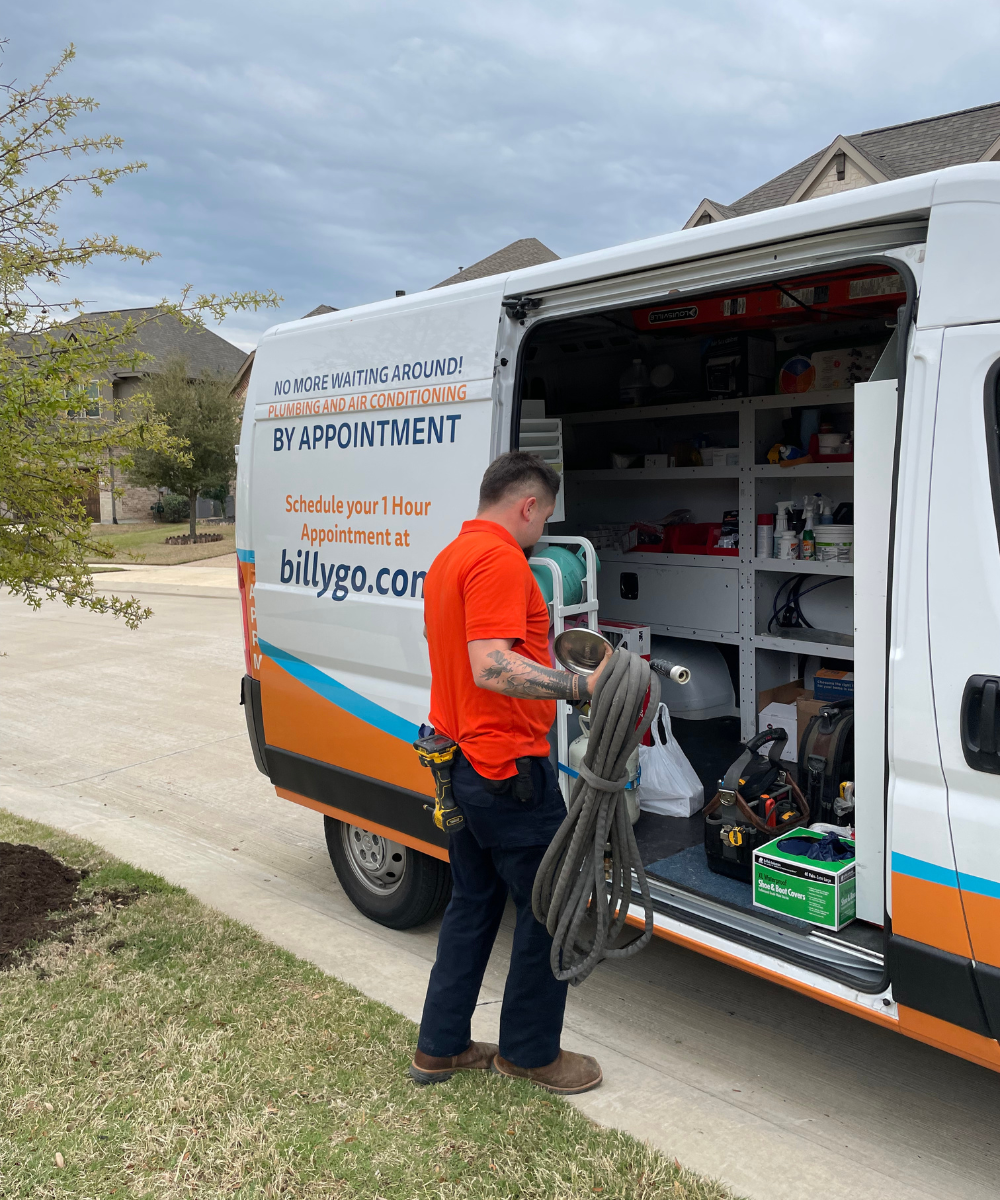Feeling the heat? Are you in need of Air Conditioner installation services in the Dallas-Fort Worth metroplex? We offer Complete end-to-end Air Conditioning services including new AC system installations, Smart Thermostats, and Custom Duct Work. We have everything you need, in stock, and ready to go. We are DFW’s fastest home HVAC installers. Go billyGO for all your residential HVAC needs.
Air Conditioner Installation
New AC System Replacement and Installation Dallas-Fort Worth
Schedule NowNew Air Conditioner Installation and Replacement
- Reasons to Buy
- Residential HVAC Tune-Ups
- What to Expect
- HVAC Ductwork Installation
- HVAC Installation Process
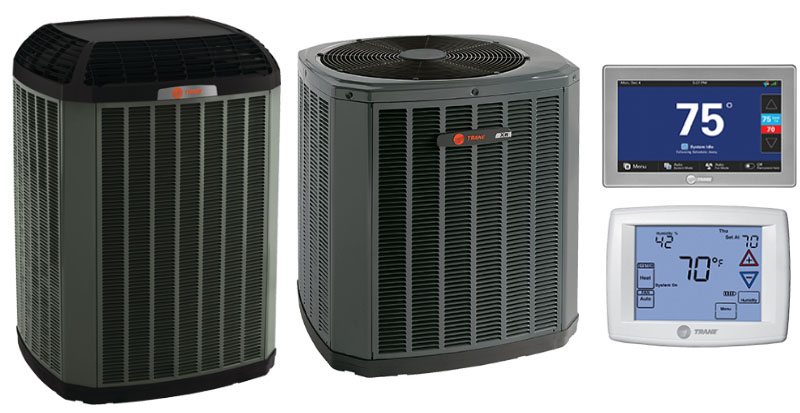
Certified professional AC installation is especially important to people in the Dallas-Fort Worth area, considering that most AC problems can be traced back to improper HVAC installation, including:
- Inaccurate load calculation resulting in an over-sized or undersized AC unit – equipment must be the right size for the house it will cool (see Load Calculation below).
- Poorly-sized or sealed ductwork – ductwork must be sized for the equipment installed.
- Inadequate power supply or overloaded breaker box – the HVAC system must be on its own electrical circuit to prevent overloaded circuits.
- Lack of space around the inside or outside units – the AC components inside and out must have enough room to allow air to flow freely around them.
- Thermostat placement – must not be located in direct sunlight or adjacent to windows or doors.
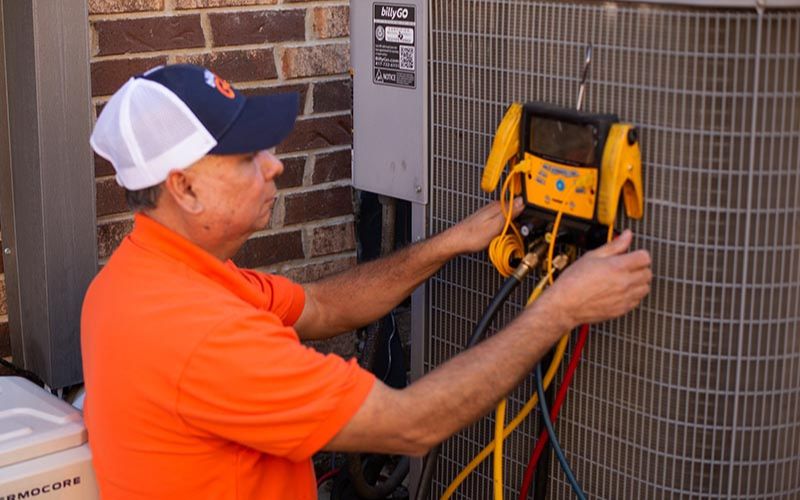
Most of our customers have us perform annual HVAC tune-ups on their equipment – air conditioners in the spring and furnaces in the fall. The small investment you make in catching minor problems pays big dividends in getting the highest performance and longest life from your heating and cooling equipment.
First, you greatly reduce the need for major air conditioning repair work. Without a spring AC tune-up, you wouldn’t know about a bad capacitor (about $100) that could cause AC compressor failure ($1,500 – $3,000 for the compressor alone) in the heat of the summer. A dirty evaporator coil can restrict airflow and cause the coil to freeze solid and render your air conditioner useless.
The other form of savings that annual AC tune-ups deliver is in lower utility bills. We tune your air conditioning equipment to factory specifications, or as close to them as their age permits. Air conditioners running at maximum efficiency use less energy, which helps hold down utility bills.
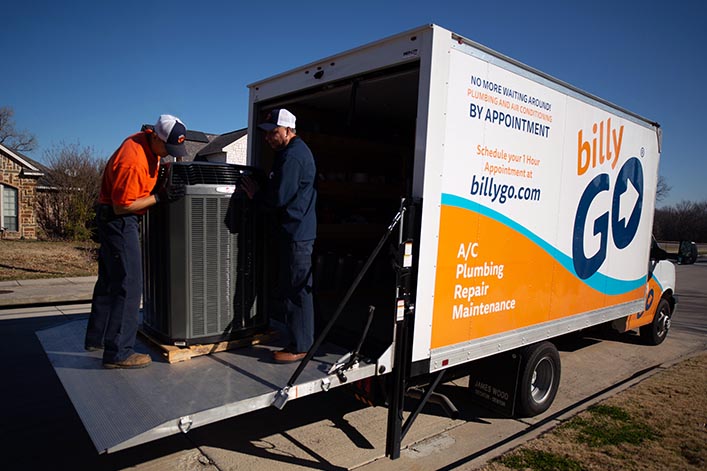
BillyGO’s licensed and NATE-certified HVAC technicians will offer accurate evaluations for your situation. We will provide guaranteed price estimates and timely service to get your AC system back up and running for the hot Texas heat.
Our goal is to provide the best service possible for our customers, within the timeframe you need it, and at a price point that works best for you and your family.
Air Conditioner cost guarantees and work timeframes are discussed up front and our technicians carry parts and equipment to ensure they arrive ready to work until their job is complete.
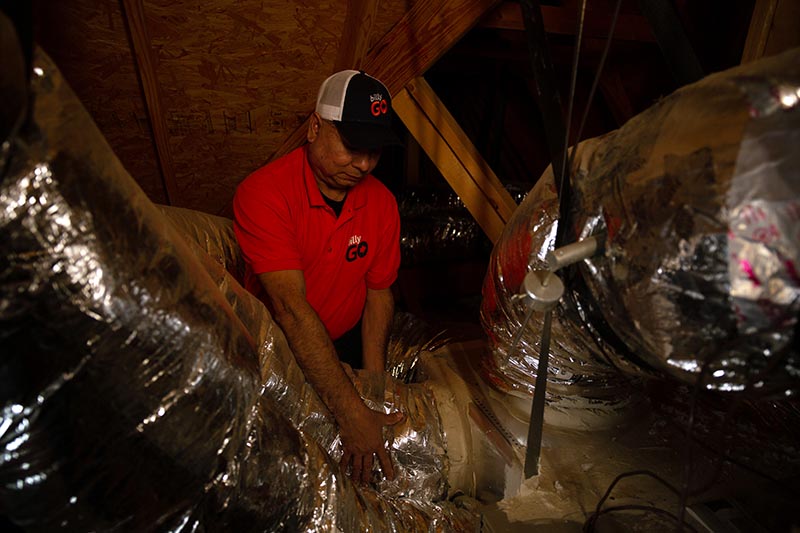
Good ductwork is essential to getting the best performance from your AC unit. Here are the most common ductwork problems we find:
- Incorrect size– ductwork always must be sized for the equipment and designed by an air conditioning professional, not a builder. Heat pumps and air purifiers require more airflow, bigger ducts.
- Poor layout – location of the air handler should be planned to avoid long runs and numerous bends, whether ductwork is flexible, sheet metal or pressed fiberglass.
- Poor duct sealing – ducts must be sealed tight where they connect to the AC/furnace equipment and along each individual run. Sometimes flex ducts are spliced together with tape that comes loose, allowing cooled air to escape into the attic. We often can improve air conditioner efficiency as much as 30% by sealing ducts
- Too few air returns – must have sufficient air returns to keep the airflow balanced, into and out of the HVAC equipment.
The Air Conditioning Contractors of America (ACCA) Manual D spells out in detail the requirements for properly-sized ductwork. The manual is lengthy, but this ACCA Manual D checklist provides a good overview.
Your billyGO air conditioning installation team will consider other factors before beginning installation, including space requirements and whether any carpentry may be required.
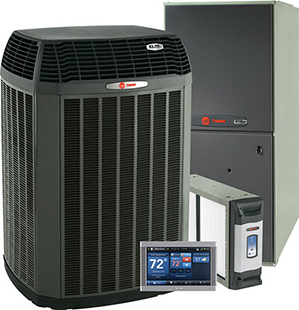
billyGO’s AC installation specialists will:
- Handle all city or county permitting for the HVAC work
- Dismantle, remove and recycle the existing air conditioning equipment
- Repair or replace existing ductwork
- Prepare the installation site, including the concrete pad for the condenser/compressor outside or installing rooftop supports for a packaged system
- Install the air handler and evaporator indoor unit
- Connect the indoor and outdoor units and ensure the appropriate size of refrigerant lines, drain piping, and electrical lines
- Connect the thermostat to the central HVAC system (new thermostats come with most new AC units)
- Remove any contaminants from the refrigerant lines and charge the new system
- Conduct an installation inspection to ensure proper installation and that the whole HVAC system functions properly
- Seasonal Energy Efficiency Ratio (SEER) Ratings
- Selecting an Air Conditioning System
- Load Calculation & HVAC System Sizing
Air conditioner efficiency is critical to your home’s comfort and the size of your summer electric bills. The higher the SEER rating, the more efficient the system. Higher efficiency air conditioning installations cost more up front but provide substantial operational cost savings and a more comfortable feel in your home.
The minimum SEER level in cooler northern states is 13 SEER, but 14 SEER for Dallas/Fort Worth and other parts of the southern and western United States. Some air conditioning equipment manufacturers offer AC units up to 25 SEER.
The chart below shows operational savings for SEER rating 10-21 compared to a baseline 8 SEER system. Most AC systems installed before Jan. 1, 2006, were 10 SEER or less. Since then, 13/14 SEER has been the minimum allowed. This SEER energy savings calculator allows you to see projected savings in dollars and percentages when comparing SEER ratings.
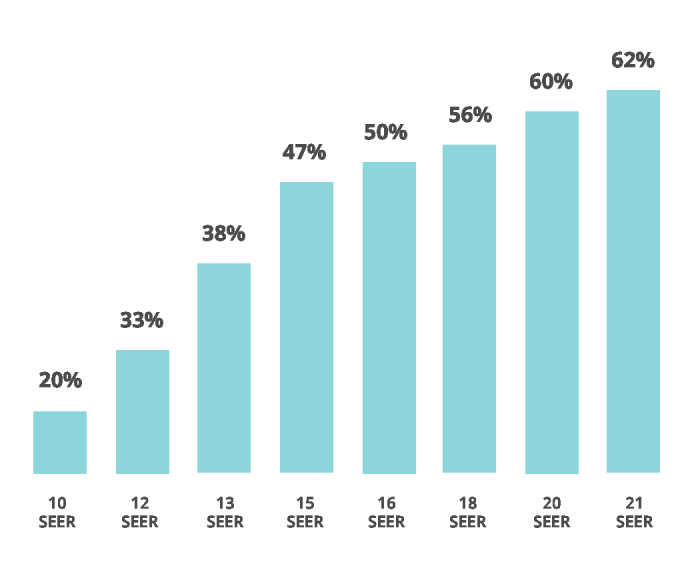 You are the best judge of what SEER rating is best for your home, weighing the operational versus installation costs. The difference in comfort or “feel” that a high-efficiency central air conditioning system provides is not quantifiable but is much greater than you may expect and well worth consideration.
You are the best judge of what SEER rating is best for your home, weighing the operational versus installation costs. The difference in comfort or “feel” that a high-efficiency central air conditioning system provides is not quantifiable but is much greater than you may expect and well worth consideration.
That increased comfort comes from two important differences – two-stage or variable-speed compressors, plus variable-speed blowers. Single-stage equipment with lower SEER values is either running full-speed or it’s off. It cycles on and off more frequently, using more power for each startup while adding additional wear and tear on the equipment.
Units with two-stage compressors (usually found at 17 SEER and higher) are designed to run at their lower speed about 80% of the time and kick into high-speed only when necessary. AC units of 18 SEER and up are available with variable-speed compressors that run only as fast as the cooling load demands.
Variable speed blower fans distribute the air through the duct system at higher speeds when more cooling is called for by the system. In addition to higher efficiency, variable-speed systems also run much more quietly.
There are four main factors to consider in selecting and installing air conditioning equipment for your home – system type, efficiency (SEER rating), size/capacity, and ductwork.
Main Types of AC Units
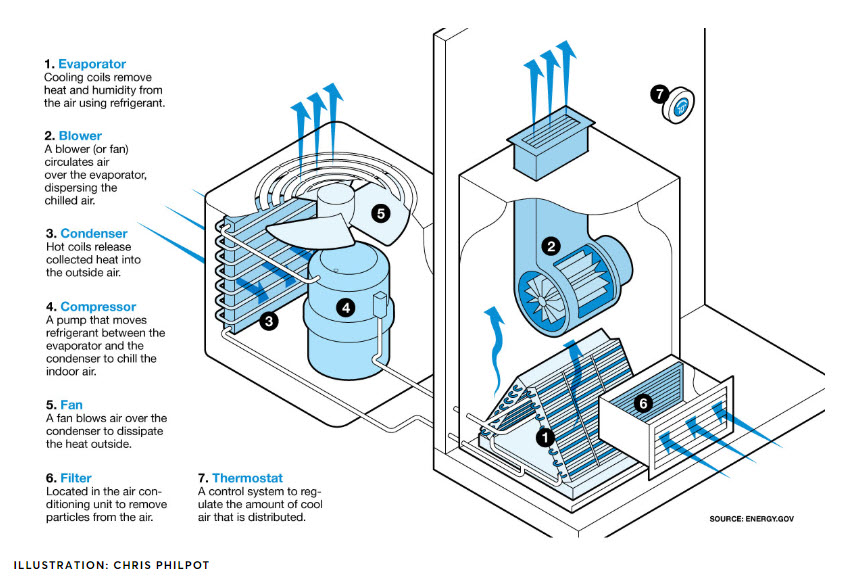
- Split system – the most common type of central air conditioning installation in the DFW metro area, featuring an outdoor metal cabinet that holds condenser coil, compressor, and a fan, plus an indoor cabinet for the evaporator. The system cools with a refrigerant that alternates between a liquid and gaseous states.
- Packaged system – one outdoor cabinet contains condenser, compressor, evaporator and fan – handy for locations where space is at a premium.
- Heat pump – these HVAC systems use outdoor air to heat homes in winter and cool them in summer by means of a reversible-flow design. The simple explanation is that heat pumps constantly move heated air from one place to another – into your home in winter and out of your home in summer.
- Ductless mini-split – this AC system requires no ductwork, which makes it a popular choice for room additions, cooling garages, utility buildings and places where adding to existing ductwork is not practical. These AC units have the condenser and compressor connected to the indoor air handler by a refrigerant line.
Calculating the load that will be placed on an AC unit is the crucial first step for air conditioning installation. The most accurate calculations are achieved with calculating room-by-room, considering factors such as wall thickness, ceiling height, insulation, ductwork, temperature extremes, roof color, amount of shade around the home, basement or slab construction, sun exposure, window sizes and a few more.
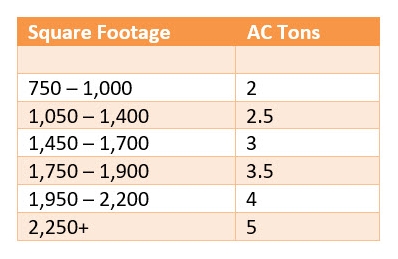 An oversized air conditioner will run in short bursts, always shutting off and on. It will never remove humidity fully and will wear out sooner. Under-sized central air conditioning equipment will run constantly, trying to keep up while increasing electricity bills and wearing out ahead of its time.
An oversized air conditioner will run in short bursts, always shutting off and on. It will never remove humidity fully and will wear out sooner. Under-sized central air conditioning equipment will run constantly, trying to keep up while increasing electricity bills and wearing out ahead of its time.
Most homeowners do not feel comfortable doing these calculations when such a significant investment is on the line. We recommend you leave this to a billyGO certified air conditioning professional.
This chart provides a working estimate that, while not precise, is useful for rough estimates you can do yourself.
See this article for more information about how central air conditioning works and how to choose a central air conditioner for your home. If you’re not certain whether to replace your air conditioner or repair it, this article provides 10 tips for deciding whether to replace an air conditioner or repair it. (Hint: you may save money with new equipment, even if your present air conditioning has some service left in it.)
Save Big with the billyGO NOW! Membership
Best in class project support and customer satisfaction
Enroll in billyGONOW today and enjoy discounted rates on annual HVAC and plumbing service and maintenance. You’ll also receive VIP treatment and the assurance of 24/7 emergency plumbing, heating, and A/C service. All of this is available for an annual fee of just $99, making it an excellent value.
- Annual heating, and A/C tune-up service to all units in your home.
- Annual plumbing inspection.
- No dispatch fees ($50 savings).
- Automatic 15% discount for all billyGO services.
- Automatic $50 discount on any Holiday service.
- VIP priority service and repairs from dedicated service technicians.
- Priority 24/7 emergency plumbing, heating, and air service.
- 15% savings on new and upgraded plumbing and HVAC equipment.
Save Big $ w/ billyGO Coupons & Specials!
Get instant access to $1000's in savings for your next billyGO plumbing, heating, and HVAC service.
Save Now!Finance Solutions
Get the Plumbing, Heating, and AC Service You Need Today. Pay Later.
We offer multiple types of stress-free financing solutions to fit your needs. These flexible financing options cover all types of plumbing, air conditioning, and heating projects. From 0% financing to no payments for 90 days and terms as long as 120 months! We are here to help.
- 0% Financing for 6, 12, 24, 36, 48 or 60 Months
- 18 Months Same as Cash
- Low-rate Financing
- 120 Months with No Payments for 90 Days
- Manufacturer rebates
- Energy company incentives
- Federal, state, and local tax credits

What Our Customers Say About Us
Testimonials From the Best Customers Ever
In Dallas Fort Worth, billyGO has been incredibly fortunate to have the most exceptional customers who have consistently supported us with their unwavering loyalty. Our gratitude extends to the hundreds of Google Reviews they’ve generously shared, applauding our staff for their outstanding work in the plumbing and HVAC industry. These reviews not only serve as tokens of encouragement for jobs well done but also provide invaluable insights on areas where we can enhance our services. We take each review to heart, actively incorporating constructive feedback into our operations. This commitment to continuous improvement is integral to our mission of building a more successful plumbing and HVAC company that consistently exceeds customer expectations.
Frequently Asked Questions
Does billyGO offer free estimates?
Absolutely! At billyGO, we understand the importance of transparency and providing a hassle-free experience for our customers. That’s why we offer FREE estimates and absolutely NO dispatch fees. When you reach out to us for your plumbing or HVAC needs, you can trust that we won’t charge you for an estimate, and there will be no surprise dispatch fees on your bill. We believe in upfront pricing and providing exceptional service from the moment you contact us. So, feel free to reach out to billyGO for a free estimate and enjoy a seamless and cost-effective experience.
What does a one hour appointment mean exactly?
A one-hour appointment with billyGO means that we guarantee our arrival within the hour of your scheduled appointment. We understand that your time is valuable, and we take punctuality seriously. In fact, we’re so committed to being on time that we offer a unique guarantee: If we arrive even a minute late, we’ll pay you one dollar for every minute we’re delayed, up to one hour. It’s our way of demonstrating our dedication to prompt and reliable service. So, when you schedule a one-hour appointment with billyGO, you can trust that we’ll be there on time or compensate you for any delay. Your satisfaction and convenience are our top priorities.
Does billyGO offer estimates over the phone or online?
No, at billyGO, we do not provide quotes over the phone or online. We believe in delivering accurate and reliable information to our customers, and since every job and situation is unique, it’s important for us to assess the specific requirements before providing pricing. We offer free estimates with no dispatch fee or commitment, ensuring that our expert technicians evaluate the job in person to provide you with an accurate quote. Beware of companies that offer estimates without inspecting the job, as this can lead to inaccurate pricing or unexpected complications. We prioritize transparency and want to ensure you receive the most reliable and fair assessment for your plumbing or HVAC needs. Rest assured, with billyGO, you’ll receive honest and accurate estimates backed by our commitment to excellent service.
Is billyGO available 24/7 and on holidays?
Absolutely! At billyGO, we are committed to providing reliable service whenever you need it most. That’s why we’re available 24/7, including holidays, to take care of your plumbing and AC needs. We understand that emergencies can happen at any time, and we don’t want you to wait for assistance. Whether it’s a late-night plumbing issue or an AC breakdown during a holiday gathering, our dedicated team is ready to serve you promptly and efficiently. We cover the Dallas Fort Worth metroplex, ensuring that you have access to quality service whenever you need it. Count on billyGO to be there for you around the clock, providing the reliable solutions you deserve.
Where is billyGO located and what areas do you service?
We’re thrilled that you asked! billyGO is conveniently located near Downtown Grapevine, Texas, close to the DFW airport. As for our service area, we proudly cater to the greater Dallas-Fort Worth Metroplex, including a wide range of suburbs such as Arlington, Plano, Irving, Frisco, Little Elm, McKinney, Southlake, Euless, Bedford, and many more. Wherever you are in the Dallas-Fort Worth area, we’re dedicated to providing exceptional plumbing and HVAC services to meet your needs. Count on billyGO to serve you with efficiency, expertise, and a commitment to customer satisfaction.
Our Service Areas
- Addison Air Conditioning Installation
- Argyle Air Conditioning Installation
- Arlington Air Conditioning Installation
- Bedford Air Conditioning Installation
- Carrollton Air Conditioning Installation
- Colleyville Air Conditioning Installation
- Coppell Air Conditioning Installation
- Dallas Air Conditioning Installation
- Euless Air Conditioning Installation
- Farmers Branch Air Conditioning Installation
- Flower Mound Air Conditioning Installation
- Fort Worth Air Conditioning Installation
- Frisco Air Conditioning Installation
- Grapevine Air Conditioning Installation
- Highland Park Air Conditioning Installation
- Highland Village Air Conditioning Installation
- Hurst Air Conditioning Installation
- Irving Air Conditioning Installation
- Keller Air Conditioning Installation
- Lantana Air Conditioning Installation
- Lewisville Air Conditioning Installation
- Little Elm Air Conditioning Installation
- North Richland Hills Air Conditioning Installation
- Plano Air Conditioning Installation
- Richardson Air Conditioning Installation
- Richland Hills Air Conditioning Installation
- Roanoke Air Conditioning Installation
- Southlake Air Conditioning Installation
- The Colony Air Conditioning Installation
- Trophy Club Air Conditioning Installation
- Watauga Air Conditioning Installation
- Westlake Air Conditioning Installation
